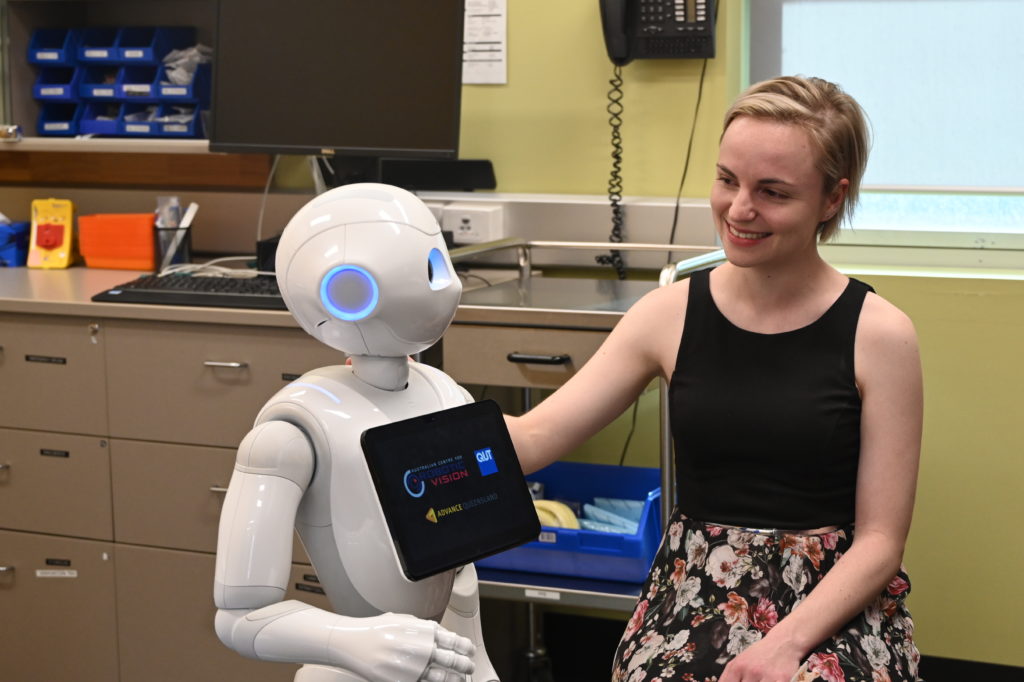According to Australian Centre for Robotic Vision Research’s Nicole Robinson, research studies on the impact of social robot interventions there have been few and unsophisticated. There is good news… the results are encouraging.
As our world struggles with mental health and substance use disorders affecting 970 million people and counting (according to 2017 figures), the time is ripe for meaningful social robot ‘interventions’. That’s the call by Australian Centre for Robotic Vision Research Fellow Nicole Robinson – a roboticist with expertise in psychology and health – as detailed in the Journal of Medical Internet Research (JMIR).
Having led Australia’s first study into the positive impact of social robot interventions on eating habits (in 2017), Robinson and the Centre’s social robotics team believes it is time to focus on weightier health and wellbeing issues, including depression, drug and alcohol abuse, and eating disorders.
 Global Trials To Date
Global Trials To Date
In the recently published JMIR paper, A Systematic Review of Randomised Controlled Trials on Psychosocial Health Interventions by Social Robots, Robinson reveals global trials to date are ‘very few and unsophisticated’. Only 27 global trials met inclusion criteria for psychosocial health interventions; many of them lacked a follow-up period; targeted small sample groups (<100 participants); and limited research to contexts of child health, autism spectrum disorder (ASD) and older adults.
Of concern, no randomised controlled trials have yet involved adolescents or young adults at a time when the World Health Organisation (WHO) estimates one in six adolescents (aged 10-19) are affected by mental health disorders. According to the agency, half of all mental health conditions start by 14 years of age, but most cases are undetected and untreated.
WHO warns: “The consequences of not addressing adolescent mental health conditions extend to adulthood, impairing both physical and mental health and limiting opportunities to lead fulfilling lives…”
In good news for the Centre’s research into social robot interventions, WHO pushes for the adoption of multi-level and varied prevention and promotion programs including via digital platforms (Read more HERE).
A Therapeutic Alliance
Despite limited amount of global research conducted on psychosocial health interventions by social robots, Robinson believes the results are nevertheless encouraging. They indicate a ‘therapeutic alliance’ between robots and humans could lead to positive effects similar to the use of digital interventions for managing anxiety, depression and alcohol use.
“The beauty of social robot intervention is that they could help to side-step potential negative effects of face-to-face therapy with a human health practitioner such as perceived judgement or stigma,” said Robinson, who has used Nao and SoftBank’s Pepper robots in her research at the Centre.
“Robots can help support a self-guided program or health service by interacting with people to help keep them on track with their health goals.
“Our research is not about replacing healthcare professionals, but identifying treatment gaps where social robots can effectively assist by engaging patients to discuss sensitive topics and identify problems that may require the attention of a health practitioner.”
In the JMIR paper, published last month, Robinson puts out a timely global call for research on social robot interventions to transition from exploratory investigations to large-scale controlled trials with sophisticated methodology.
At the Australian Centre for Robotic Vision’s QUT headquarters, she’s helping to lay the groundwork. The Centre’s research, sponsored by the Queensland Government, is assessing the capabilities of social robots and using SoftBank Robotics’ Pepper robot to explore applications where social robots can deliver value beyond their novelty appeal.
Social Robot Trials
In 2018, the Centre’s social robotics team initiated a set of trials involving Pepper robots to measure the unique value of social robots in one-to-one interactions in healthcare. After supporting an Australia-first trial of a Pepper robot at Townsville Hospital and Health Service, the Centre’s team has placed Pepper into a QUT Health Clinic at Kelvin Grove Campus.
The three-month study to June 2019 involves Pepper delivering a brief health assessment and providing customised feedback that can be taken to a health practitioner to discuss issues around physical activity, dietary intake, alcohol use and smoking. Members of the public who are registered as patients at the QUT Health Clinic are invited to take part in this trial.
In a separate online trial, the Centre’s social robotics team is assessing people’s attitudes to social robots and their willingness to engage with and discuss different topics with a robot or human as the conversation partner.
For more information on the Australian Centre for Robotic Vision’s work creating robots able to see and understand like humans, download our 2018 Annual Report.
Editor’s Note: This article was republished with permission from The Australian Centre for Robotic Vision. The original article can be found HERE.
The post Prescribing a Robot ‘Intervention’ appeared first on The Robot Report.
